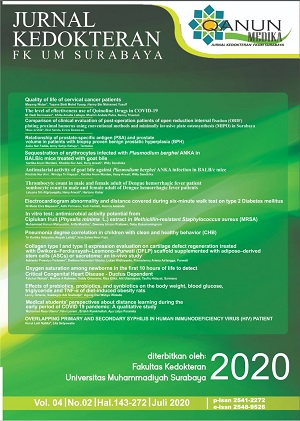Antimalarial activity of goat bile against Plasmodium berghei ANKA infection in BALB/c mice
Abstract
Abstract
Â
Goat bile has been used by some Indonesian people to treat malaria and increase their stamina. This study aimed to prove whether goat bile toxic or not in BALB/c mice and to verify the antimalarial activity of goat bile at various concentrations in mice infected with Plasmodium berghei ANKA. Acute toxicity test was performed using twenty male BALB/c mice with an average body weight of 25 grams, which were divided into four groups. Mice were given 25%, 50%, and 100% goat bile, respectively, while negative control was given distilled water. Any change in weight, odor, color, agitation, appearance, color of urine and feces, coma, and death, were recorded. A different set of mice were infected with P. berghei ANKA. This study conducted using the posttest only control group design with four treatments and five replications. A four day-treatment of goat bile was given by oral gavage to find out its effect on parasitemia level. Infected mice were divided randomly into 4 groups, where the GBNeg group as negative control was given only distilled water. The GB25, GB50, and GB100 groups were treated with 25%, 50%, and 100% goat bile, respectively. The parasitemia was observed daily on Giemsa-stained tail blood smears of each mice. No death or other sign of toxicity was found in goat bile-treated mice. Goat bile showed anti-malarial activity. The parasitemia in all goat bile treated groups was lower compared with the negative control group. The ED50 of goat bile against the growth of parasite was 48,55 %. Goat bile is a potential source of new antimalarial therapies. Further investigations are recommended to yield new anti-malarial drug candidates.
Â
Keywords               :   Goat bile, parasitemia, Plasmodium berghei ANKA, ED50
Correspondence    :   heny-a@fk.unair.ac.id
Full text article
References
Ackerman, H. D., & Gerhard, G. S. (2016). Bile acids in neurodegenerative disorders. Frontiers in Aging Neuroscience, Vol. 8, p. 263. https://doi.org/10.3389/fnagi.2016.00263.
Avrina, R., Risniati, Y., Siswantoro, H., Hasugian, A. R., Tjitra, E., & Delima. (2011). Hubungan kepadatan parasit dengan manifestasi klinis pada malaria Plasmodium falciparum dan Plasmodium vivax. Media Litbang Kesehatan, 21(3), 120–126. https://doi.org/10.22435/mpk.v21i3Sept.93. In Indonesian language.
Basir, R., Rahiman, S. S. F., Hasballah, K., Chong, W. C., Talib, H., Yam, M. F., … Ahmad, Z. (2012). Plasmodium berghei ANKA infection in ICR mice as a model of cerebral malaria. Iranian Journal of Parasitology, 7(4), 62–74.
Boyer, J. L. (2013). Bile formation and secretion. Comprehensive Physiology. https://doi.org/10.1002/cphy.c120027.
Bujang, I. (1994). Makanan: wujud variasi dan fungsinya serta cara penyajiannya pada orang Melayu, Jambi. Departemen Pendidikan dan Kebudayaan. In Indonesian language.
de Buy Wenniger, L. M., & Beuers, U. (2010). Bile salts and cholestasis. Digestive and Liver Disease, Vol. 42, pp. 209–418. https://doi.org/10.1016/j.dld.2010.03.015.
Fidock, D. A., Rosenthal, P. J., Croft, S. L., Brun, R., & Nwaka, S. (2004). Antimalarial drug discovery: Efficacy models for compound screening. Nature Reviews Drug Discovery, 3, 509–520. https://doi.org/10.1038/nrd1416.
Hapsari, W. T., Novriandika, D., Ramadhani, R. B., & Arwati, H. (2014). In vivo and in vitro tests on antimalarial activity of goat bile against Plasmodium berghei and Aqueous extract of goat bile against P. falciparum. The 1st International Symposium of Traditional, Complementary and Alternative Medicine (TradCAM). Surabaya, 12-13 April 2014.
Herold, B. C., Kirkpatrick, R., Marcellino, D., Travelstead, A., Pilipenko, V., Krasa, H., … Cooper, M. D. (1999). Bile salts: Natural detergents for the prevention of sexually transmitted diseases. Antimicrobial Agents and Chemotherapy, 43(4), 745–751.
Holan, K. R., Holzbach, R. T., Hermann, R. E., Cooperman, A. M., & Claffey, W. J. (1979). Nucleation time: A key factor in the pathogenesis of cholesterol gallstone disease. Gastroenterology, 77(4 Pt 1), 611–617.
http://manfaat.co.id. (2018). Manfaat Empedu Kambing Jantan bagi Tubuh. In Indonesian language.
Kemenkes, R.I. (2016). Kombinasi derivat artemisinin sebagai obat antimalaria yang efektif. Retrieved August 30, 2019, from https://www.kemkes.go.id/article/view/16050300001/kombinasi-derivat-artemisin-sebagai-obat-anti-malaria-yang-efektif.html. In Indonesian language.
Kitua, A. Y., & Malebo, H. M. (2004). Malaria control in Africa and the role of traditional medicine. In M. Willcox, G. Bodeker, P. Rasoanaivo, & J. Addae-Kyereme (Eds.), Traditional Medicinal Plants and Malaria (1st Editio). Boca Raton: CRC Press.
Kotepui, M., Piwkham, D., PhunPhuech, B., Phiwklam, N., Chupeerach, C., & Duangmano, S. (2015). Effects of malaria parasite density on blood cell parameters. PLoS ONE, 10(3), 3. https://doi.org/10.1371/journal.pone.0121057.
Li, S., Tan, H. Y., Wang, N., Hong, M., Li, L., Cheung, F., & Feng, Y. (2016). Substitutes for bear bile for the treatment of liver diseases: Research progress and future perspective. Evidence-Based Complementary and Alternative Medicine. https://doi.org/10.1155/2016/4305074.
Muluye, A. B., Desta, A. G., Abate, S. K., & Dano, G. T. (2019). Anti-malarial activity of the root extract of Euphorbia abyssinica (Euphorbiaceae) against Plasmodium berghei infection in mice. Malaria Journal, 18(261). https://doi.org/10.1186/s12936-019-2887-7.
Penna-Coutinho, J., Cortopassi, W. A., Oliveira, A. A., França, T. C. C., & Krettli, A. U. (2011). Antimalarial activity of potential inhibitors of Plasmodium falciparum lactate dehydrogenase enzyme selected by docking studies. PLoS ONE. https://doi.org/10.1371/journal.pone.0021237.
Pusdatin. (2016). Malaria. Pusat Data dan Informasi Kementerian Kesehatan Republik Indonesia. Retrieved February 10, 2019, from https://pusdatin.kemkes.go.id/resources/download/pusdatin/infodatin/InfoDatin-Malaria-2016.pdf. In Indonesian language.
Wang, D. Q. H., & Carey, M. C. (2014). Therapeutic uses of animal biles in traditional Chinese medicine: An ethnopharmacological, biophysical chemical and medicinal review. World Journal of Gastroenterology. https://doi.org/10.3748/wjg.v20.i29.9952.
WHO. (2018). World Malaria Report. Retrieved October 1, 2019, from WHO website: https://apps.who.int/iris/bitstream/handle/10665/275867/9789241565653-eng.pdf?ua=1.
Zeleke, G., Kebebe, D., Mulisa, E., & Gashe, F. (2017). In Vivo Antimalarial Activity of the Solvent Fractions of Fruit Rind and Root of Carica papaya Linn (Caricaceae) against Plasmodium berghei in Mice. Journal of Parasitology Research. https://doi.org/10.1155/2017/3121050.
Authors

Qanun Medika by FK UM Surabaya is liscence under Lisensi Creative Commons Atribusi 4.0 Internasional.

